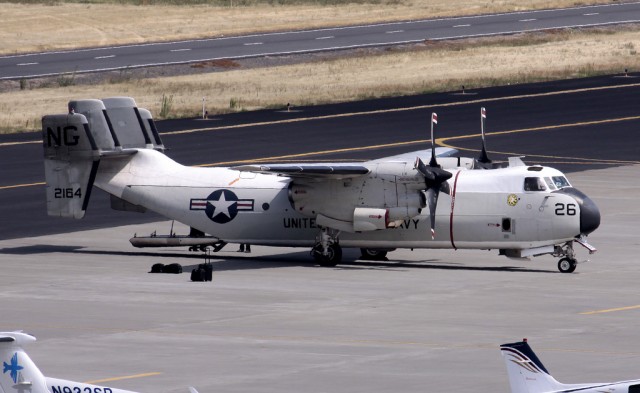
The ubiquitous C-2 that the has become a welcome sight on carrier decks – Photo: Paul Carter
Since 1966, the United States Navy has employed the venerable Grumman C-2 Greyhound as its main source of supplying their fleet of nuclear-powered aircraft carriers with a vital connection to the outside world. Known as the CODs (for Carrier Onboard Delivery), these aircraft transport personnel, spare parts, mail, and other necessities to the carriers from land.
The C-2, based on the Grumman E-2 Hawkeye AWACS platform, can carry up to 26 passengers or 10,000 pounds of cargo to and from an aircraft carrier. The mission of the C-2 has been considered one of the most important in the operations of an aircraft carrier. With the first of 17 C-2s delivered in 1966, and the last in 1968, by the early 80’s, the fleet was beginning to show its age and limitations.
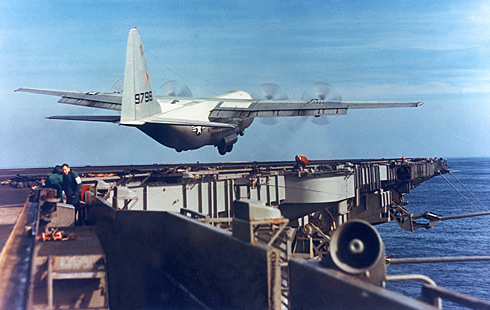
KC-130 flown by Lt. Flatley departs the USS Forrestal after one of its 21 landings – Photo: US Navy
So, what does the C-2 have to do with airliners? In the early 1980’s, the US Navy put out a request for a new COD aircraft through the MMVX program. Various manufacturers tendered proposals, including Grumman, with an improved version of the C-2. Lockheed offered a new, turbofan design derived from the S-3 Viking, and a few unusual proposals.
Fokker Aircraft, of the Netherlands, proposed a derivative of their successful F28 regional airliner, called the F28 Mk.5000. McDonnell Douglas proposed a navalized version of the venerable DC-9-10 airliner, and lastly, it appears as if Boeing proposed a carrier modification of the 737-200. While it might seem odd operating an aircraft the size of an airliner off of the small flight deck of an aircraft carrier, the concept was proven as possible nearly 20 years before the start of the MMVX program.
In November 1963, the Navy conducted tests to see if the idea of a ’œSuper COD’ was possible. These dramatic tests saw a crew, led by Lt. James Flatley, land a KC-130 on the deck of the USS Forrestal 21 times with no tailhook, and take off with no catapult assistance. These tests, while a success, proved that the C-130 was too large of an aircraft to routinely operate off of a carrier, and the Navy in the end procured the C-2.
For this story, I want to take a closer look at the proposed airliners which were made to handle carrier operations.
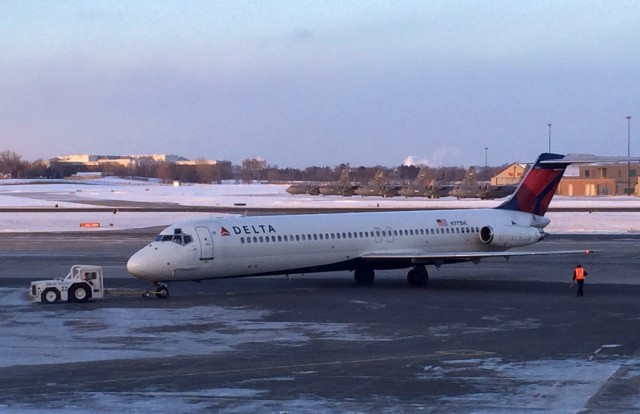
Delta flight 2014, the final scheduled DC-9 (reg N773NC) flight, pushed back from the gate at MSP – Photo: Chris Spradlin
It was a cold day in Minneapolis, the coldest in decades. Despite the bitter temperatures, spirits were high at Minneapolis – St. Paul International Airport (MSP) as Delta Air Lines was preparing to operate their final scheduled McDonnell Douglas DC-9 flight. As the aircraft touched down after the first flight of a two-leg ceremonial routing, the sendoff began and the DC-9 would soon be history.
A small gathering of Delta pilots, flight attendants, and tech ops were on hand to say goodbye to an old friend. A banner commemorating the DC-9 was hung on the wall for all to sign as passengers and employees indulged in the decorative DC-9 cakes. Before boarding, a ground operations employee shared some final thoughts about the DC-9, slipping up and saying “on behalf of Northwest Airlines,” which really sums up the history of the DC-9 at Delta.
Born 48 years ago, the DC-9 has outlived many other fleet types since its introduction with Delta in 1965. The DC-9 was once before retired from the Delta fleet in 1993, but was introduced again in 2008 after the merger with Northwest Airlines. Northwest also inherited their DC-9s via a merger, this time with Republic Airlines in 1986. The airframe which operated the final flight, N773NC, started its life with North Central Airlines in 1978.
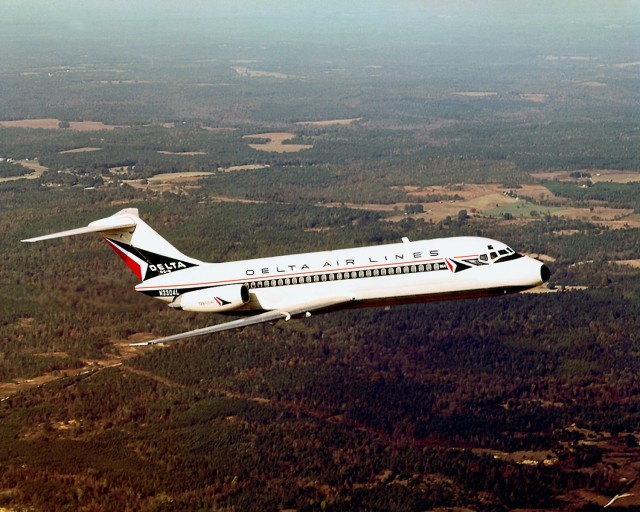
DC-9 “Delta Prince” in flight over wooded area, taken in the 1960’s. Image courtesy of Delta Air Lines.
This Story was Written by Andrew Vane for AirlineReporter.com:
Last summer I had the pleasure of writing an aircraft highlight article on the Mad Dogs and their history which began with the DC-9 and has brought us to the Boeing 717. About a year ago, Delta Air Lines, one of the last US airlines still operating the DC-9’s, announced that they would be retiring the last remaining 35 DC-9-50’s over the next 12-18 months. As of September 2011 the number of DC9’s in use was down to about 27.
In Fall 2011, I realized that I had to plan a business trip to Nashville from Charlotte for a national conference related to my work. While air travel is not usually a part of my work, I really enjoy choosing flights based on aircraft within my travel window, not only for comfort but for the experience. What I realized for this trip is that the Charlotte to Atlanta flights and Atlanta to Nashville flights afforded a wide selection in aircraft type from the telephone booth sized CRJ’s to the A319 and MD-88’s. What’s this? There are DC-9’s on that route?
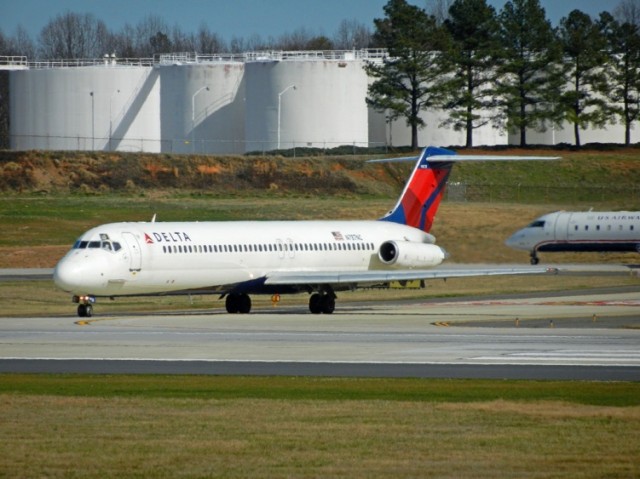
Delta DC-9 taxis onto Runway 18C at Charlotte, NC. Photo by Andrew Vane.
This means I have an opportunity to actually fly in what’s likely to be a museum piece in the near future. I suddenly realized I had to jump on this opportunity to ride this workhorse of the short range market before the opportunity is gone. As it turns out, I managed to book 3 of my 4 flight legs on the glorious DC-9-50. Only my Atlanta to Nashville flight would be on a different aircraft; the Airbus 319) The table below highlights the aircraft I was privileged to fly in for this trip:
| Flight Leg |
Aircraft Type |
Registration |
Year Built |
| Charlotte-Atlanta |
DC-9-50 |
N675MC |
1975 |
| Atlanta-Nashville |
Airbus A319 |
N302NB |
2000 |
| Nashville-Atlanta |
DC-9-50 |
N767NC |
1977 |
| Atlanta-Charlotte |
DC-9-50 |
N784NC |
1978 |
The DC-9 first entered service in 1965 with Delta as the launch customer. Delta eventually phased out the DC-9’s but reacquired them (along with Boeing 747’s and Airbus A319, A320 and A330’s) when it merged with Northwest Airlines in 2008.
I’ve been excited about this trip ever since I booked it last month with my company’s travel agent. If you’re looking for a luxurious flight experience, this aircraft is not the place to find it. Hopefully this article will contrast with the web site founder’s exotic meal laden VIP trips the rest of us common folk can only dream of taking. J My previous story on the Mad Dogs drew some comments regarding the smell of the lavatory wandering throughout the cabin. I sat right over the wing and couldn’t even smell a hint of the lavs. I could see every single rivet and bolt on the wing though.
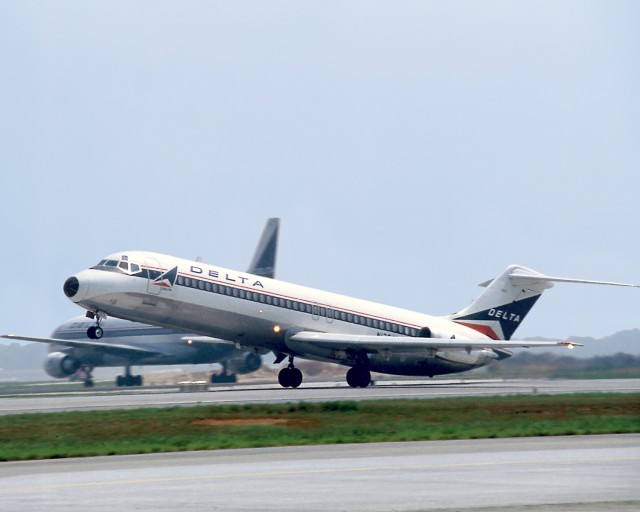
Delta DC-9 in updated livery. Check out the L1011 in the background. Image courtesy of Delta Air Lines.
As I strapped myself in, I couldn’t help but notice how modern the interior of Delta’s DC-9’s look. They’ve spared no expense in making you feel business as usual on all their aircraft, whether they’re 10 years old or 30. The captain came on and told us he was going to be starting the engines at the gate and that the lights would flicker a bit while he ran through some electrical checks. I almost expected to see some guy come out with a hand crank. I’m not sure if the gate startup is because they need ground power or for some other reason.
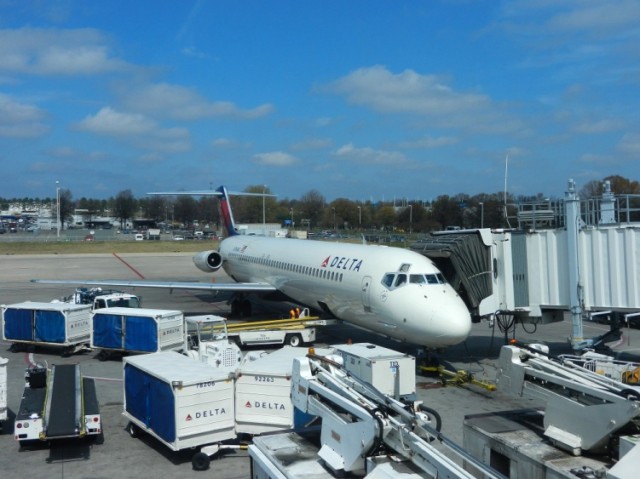
DC-9-50 at Delta’s gates in Charlotte, NC. Photo by Andrew Vane.
The DC-9 uses Pratt & Whiney JT8D turbojet engines with about 16,000 lbs of thrust each, the same type used by the 727, MD-88 and early versions of the 737. By contrast, the Airbus 319 uses European made CFM engines each are rated at 25,000 lbs of thrust each. I was thankful Charlotte has a 10,000 foot long runway because I figured we’d be needing all of it that day.
As expected, as we began our takeoff roll, I noticed it was taking quite a long time to get down the runway. It took a good 40 seconds to go from a rolling start to the hind wheels leaving the pavement. By comparison, the similarly sized A319 took 30 seconds to takeoff, but that was from a dead stop. The difference between engine thrust in the two aircraft was obvious. Still, the rumble in the DC-9 was definitely more fun an experience.
The flight went smoothly, the air conditioner worked, and we arrived right ’œon time,’ although I think the airline adds to the official travel time to allow for ground traffic and taxiing.
At the time of my travel in March, Hipmunk.com (an airline travel web site I frequent) showed Delta’s last DC-9 flights between Charlotte and Atlanta ending June 6th (being replaced with its longer MD88 cousin) and DC-9 flights from Atlanta to Memphis ending sometime in early October (being replaced with MD88’s and A319’s). However, one Delta pilot who took a lot of time after my first flight answering my questions told me Delta plans to fly DC-9’s at least for an additional year and plans a DC-9 ’œjet base’ for pilots in Atlanta. For now, I can postpone my farewell for at least another year or so.
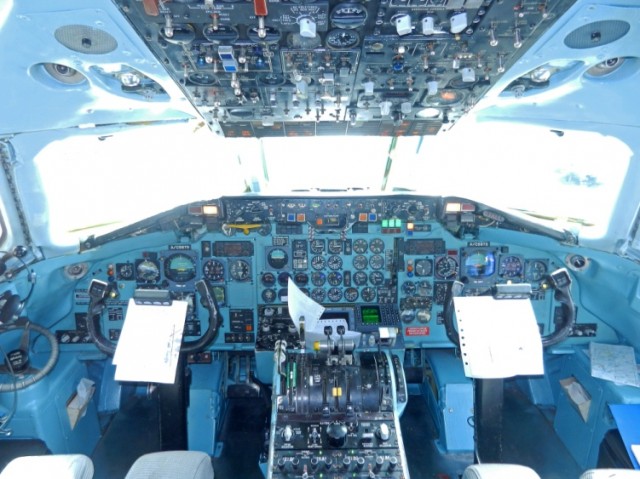
Teal Anyone? No FMC here. Its old school flying for sure.
Some of you fliers may enjoy the comfort and luxury of the newer aircraft. As I get older, I’m becoming more nostalgic and appreciating the older classics in life like a fine Merlot, Vivaldi and the DC-9.
I want to express my sincerest thanks to the Delta pilot Mark who took time to talk with me following each flight. My former landlord, a Delta 757 pilot, told me once after sitting in the jump seat of a DC-9 ’œBoy, those guys sure do work!’ Unlike the MD-80 series, the DC-9’s never received a cockpit upgrade. The pilots use nothing but the original steam gauges and fly VOR to VOR. While the newer aircraft with FMC’s let the aircraft fly the needle during cruise, the DC9 pilots often don’t know they’re off course until its too late. One pilot shared this with me and said he’d sometimes received ’œwhere are you going?’ questions from ATC after straying a bit off the route. ’œIf you’re within 4 miles you’re good,’ he told me.
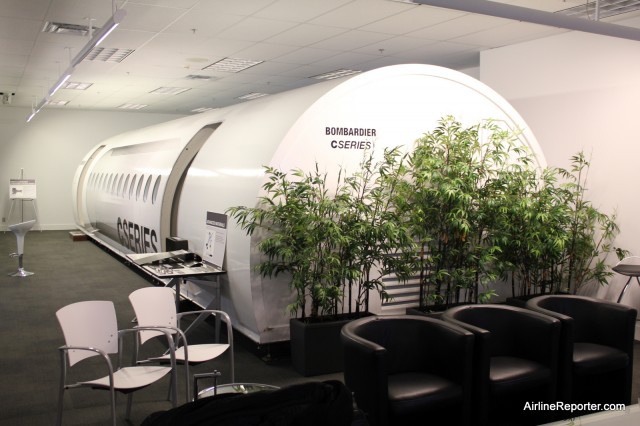
Bombardier's Cseries located in Montreal, Quebec -- tres bon!
After spending the day with Bombardier recently to learn about their new CSeries, the biggest thing I pulled away that you, the passenger will care the most about is SPACE — lots of it. This is the interior that many passengers have been begging for and they are finally going to get it. All the time , I hear people asking for wider seats, more room, etc. But really, what airline is going to take a Boeing 737 or Airbus A320 and go from six seats across to five? (hint: none). The CSeries is designed to provide that extra space that passengers want, but not the additional weight that costs the airlines more money. Bombardier has built enough width into their new CSeries to give passengers extra room, but not enough for airlines to fit in additional seats.
The cabin of the CSeries is set up in a 2-3 layout for economy and 2-2 layout for first class. Personally, I have always loved this layout on the DC-9/MD-80/Boeing 717 aircraft. If you are flying with someone, it gives you the chance for you two to sit together on the two side and not be bothered by a third person. A big downside of those older aircraft was the noise level in the back of the plane from the engines being rear mounted. That won’t be a problem with the CSeries, since the engines are wing-mounted.
Some readers on my Facebook pointed out that having a wider seat is not something new. Piedmont Airlines did it, but it surely has been a long while and really this comes from the design of the aircraft, not from an airline deciding to make the middle seat wider.
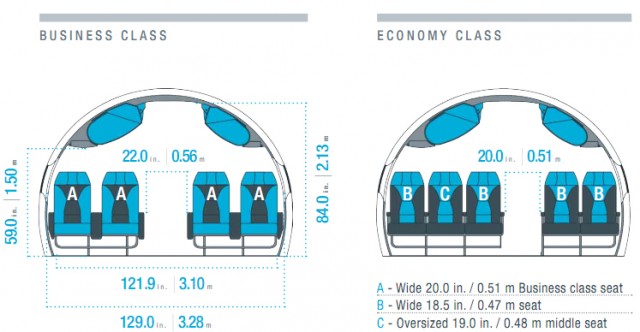
There is plenty of width in the new Bombardier CSeries. Image from Bombardier.
The interior is designed so that most economy seats have 18.5″ width — except the middle seat which is 19″. Now, this just blew my mind… the middle seat is actually 1/2″ wider than the other seats on the plane. How genius is that? Not only that, but a standard 18.5″ width for a short haul seat is great. Many airlines run wide-body, long haul flights with only 18″ or even 17″.
Now, I know what you are all thinking, “Yea right. Bombardier might design the aircraft with space, but airlines will find ways to use that space to fit in as many seats as possible.” Well, do not worry, that will not be the case. First off, there is about half a seat width (from an average aircraft) of extra space built into the plane. If you do the math and an airline puts the aisle to 18″, that would mean each seat would be 15.8″ and that just is not going to happen. Plus, the plane is designed to hold so many passengers with the emergency exits given, so even if an airline made impossibly thin seats, most of them would have to remain empty.
Although seat width will be pretty standard, airlines will have choice with what seat pitch they want to offer. The CSeries mock up in Montreal has the rows set up with different examples from 32″ to 28″. Let me say that at 6’1″, I really hope no airline opts for the 28″ seat pitch on any airplane — ever.
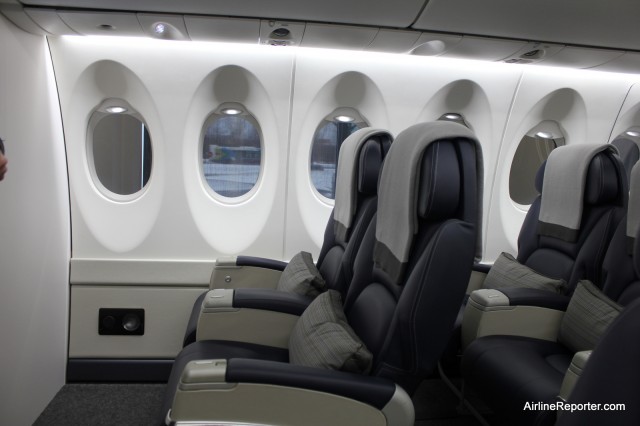
The windows are quite large on the new CSeries, providing more natural light and shoulder room.
The CSeries will sport larger windows than its competition, allowing more natural light and a bit more shoulder room. The CSeries will have windows measuring 11×16″, which are about the size you would find on a Boeing 777.
If you choose a window seat, rest assured, you will actually get a window. How annoying is it to get to your window seat and see a solid wall with no window? Bombardier designed the CSeries so that each row would have at least one window. Not only does this provide great spotting opportunities, it also allows more natural light into the cabin.
At this point, it appears that each window will have a traditional sun shade and not the electronic ones found on the 787 Dreamliner. The reason is this is a smaller aircraft, running shorter hops than the 787 and the extra cost really did not make sense. Like the Dreamliner, the CSeries will also have LED lighting that can change color based on what the airline customer might want.
The aircraft is set to compete directly with the Airbus A318 and A319, the Boeing 737-600 / 737-700, and the Embraer E-195. Bombardier is also hoping those airlines that operate DC-9s and MD-80 aircraft (I am talking to you American and Delta Air Lines) might want to update their fleet with the CSeries.
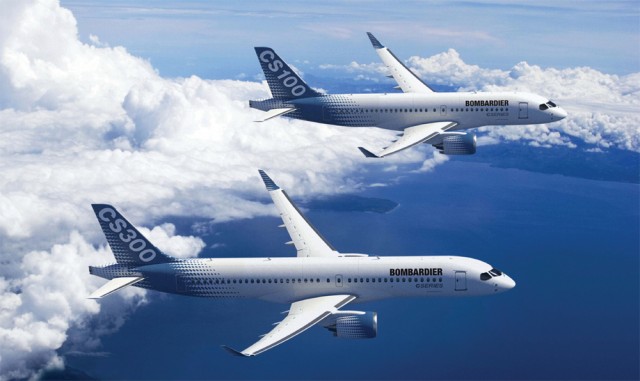
A look at the CSeries 100 and CSeries 300 in this computer mock up from Bombardier.
When designing the CSeries, Bombardier decided to use an aluminum alloy for the fuselage and composite wings. “For the fuselage we performed trade-off analyses, involving airlines in the process, between composite and advanced aluminum design options,” Sebastien Mullot, CSeries Program Director at Bombardier, explained to AirlineReporter.com. “It turned out that the weight gain in the composite option was not as important as in other composite parts (e.g wing) and airlines drew our attention to the fact that this weight gain might be offset by the additional costs that could be incurred on the maintenance side.”
Since the CSeries will be a high-cycle aircraft, there is a much higher chance that the aircraft will be damaged during normal operations. Currently, repairing composite aircraft requires special equipment and procedures, which would have increased operational costs and complexity for airlines. The aluminum alloy used on the CSeries is a aluminum-lithium hybrid that is lighter than traditional aluminum and still can be repaired easily. For now, it seemed to be a perfect fit for what the CSeries will be doing.
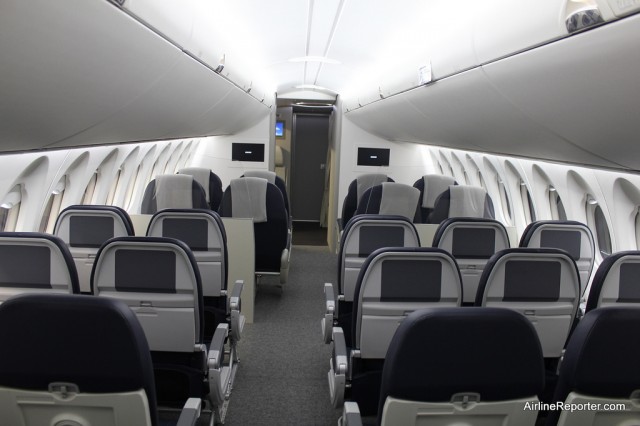
The mock up for the CSeries has different seat pitches for each row. You can see that some have fake entertainment screens as well.
Bombardier is confident that the CSeries will have its first flight before the end of the year. When I asked about potential delays, they stated that they had built-in time for potential delays and unlike other aircraft manufacturers, they have been outsourcing part of their aircraft production for a very long time and are well experienced. They have already been able to work out the kinks and problems from experiences learned with previous aircraft and have not seen the issues that other companies have (ie Boeing and Airbus).
The company hopes that the CSeries will be a complete package for airlines, passengers, crew and the environment. “In an challenging economic environment, airlines have been seeking to grow their average aircraft size in a race to improve their cost efficiency,” Mullot explained. “This aircraft will also be the only single-aisle aircraft to meet 21st century operating requirements: improving flight crew situational awareness, meeting new air traffic control needs and dramatically reducing airlines’ environmental footprint!”
One interesting fact is that we do not know who the launch customer for the CSeries will be. That customer has asked to remain secret and Bombardier is not talking. I am hoping it will be a game changer like Southwest, Ryanair or EasyJet who all operate single aircraft type, but it likely will not be that exciting.
OTHER CSERIES STUFF YOU MUST CHECK OUT:
* All 17 photos of the CSeries mockup in Montreal
* Video of the second mock up by Simpliflying
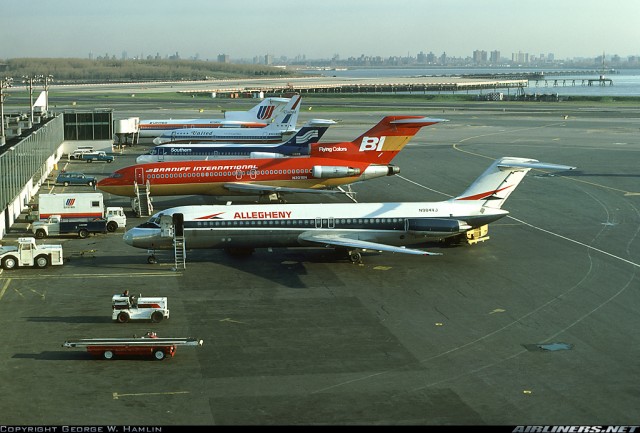
Some real classics as seen at New York's La Guardia in 1977. Click for larger.
You might be an airline nerd if you spent a good chunk of your time looking at random photos of classic airliners on the internet. Well, I happen to do just that more than I want to admit. Every once in a while I come across one that really moves me for one way or another and I want to share.
I just love this photo with the Allegheny DC-9 (N964VJ) parked next to the Braniff International Boeing 727-100 (N301BN) and next to a Southern DC-9. I think the best part are the Boeing 737 and 727 in different United Airlines livery.
The Boeing 737 is in the Friend Ship livery and the Boeing 727 is in the newer tulip livery, that matches the United service truck. Also notice the Allegheny tug is sporting their “new” livery that was then used on USAir after their purchase.
A special thanks to George Hamlin for taking this photo and letting me use it.













